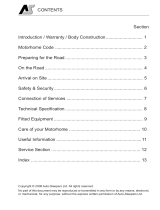
Petrol is a highly flammable liquid and any spillage will evaporate to form a flammable, heavier than air vapour which is easily ignited.
Common ignition sources include, but are not limited to, smoking and lit matches, welding and cutting equipment, heaters, all types of
electrical equipment unless specifically designed as suitable for use in flammable atmosphere. Even low voltage inspection lamps, if
damaged, can ignite petrol vapour
Please take time to read the following safety information before commencing work with the TP200S.
4 Use the drainer only for its intended purpose.
4 Familiarise yourself with the applications, limitations, and potential hazards of this product.
4 Use original Sealey spare parts only. Unauthorised parts may be dangerous and will invalidate the warranty.
4 We recommend that the TP200S is used outdoors or in a well ventilated area, and well away from pits or other openings in the ground
where vapour can collect.
4 Disconnect the vehicle's battery before draining fuel.
4 Keep a foam or dry powder fire extinguisher nearby.
4 Ensure containers cannot easily be knocked over during filling.
4 Ensure the drainer tank is large enough to hold the contents of the fuel tank you are draining.
4 Ensure space required for use and maintenance of the drainer is adequate, free from
unrelated materials and has good lighting.
4 Attach earth lead to the fuel container using the crocodile clip supplied.
4 Always use the earth bonding straps by connecting one to the vehicle chassis, away from
any potential fuel vapour, and the other to a suitable earthing point.
4 Remove all combustible materials from the work area.
4 Use only containers rated for the fuel being drained. Ensure that the container mouth is as
narrow as possible while still allowing insertion of the drain hose.
4 HSE guidance recommends use of metal containers with secure caps for holding drained
fuel.
4 Mark fuel containers with hazard labels to show their contents.
4 Keep any fuel containers in a well ventilated, lockable store, preferably outside the working
area.
4 Soak up any spills immediately using absorbent granules or similar material.
4 Keep children and unauthorised persons away from the working area, especially when the
drainer is in operation. Keep the work area childproof by using padlocks and master
switches.
4 Maintain the drainer in top condition. Keep it clean for best and safest performance.
4 Follow the same precautions when transferring fuel from the drainer back into the vehicle or into any other container.
8 DO NOT use this drainer for anything other than its intended purpose. The TP200S is only to be used for pumping fuel from diesel or
petrol vehicles.
8 DO NOT work on a fuel tank or remove a sender unit before draining the fuel.
8 DO NOT use an open flame or smoke anywhere near the drainer or around stored fuel.
8 DO NOT drain fuel into open-topped containers such as buckets and watering cans.
DO NOT drain fuel into dedicated workshop oil drain equipment.
8 DO NOT drain fuel into plastic containers except for quantities less than 10 litres.
8 DO NOT allow work which can produce a source of ignition, such as welding, electrical or other hot work, to be carried out while
draining petrol.
8 DO NOT drain fuel over, or close to, a pit or drain because of the risk of flammable vapour accumulation.
8 DO NOT use any electrical equipment on or near the vehicle while fuel draining is in progress. This includes the use of inspection
lights, cordless/mobile phones or pagers.
8 DO NOT store drained or contaminated fuel in the workplace unless it is to be returned to the vehicle immediately.
8 DO NOT wear clothing on which petrol has been spilt - stop work and change into uncontaminated clothing before continuing to work.
8 DO NOT use the drainer if the pump is damaged in any way.
8 DO NOT leave the unit running unattended.
8 DO NOT use whilst under the influence of drugs, alcohol or other intoxicating medication, or if you are fatigued.
8 DO NOT tamper with the safety valve fitted to the tank.
AIR OPERATED FUEL DRAINER 40L - STAINLESS
STEEL
MODEL No: TP200S
Users/Businesses should perform their own risk assessment based on their specific
environment and following the guidelines laid out above.
Original Language Version
© Jack Sealey Limited
IMPORTANT: PLEASE READ THESE INSTRUCTIONS CAREFULLY. NOTE THE SAFE OPERATIONAL REQUIREMENTS, WARNINGS & CAUTIONS. USE THE PRODUCT
CORRECTLY AND WITH CARE FOR THE PURPOSE FOR WHICH IT IS INTENDED. FAILURE TO DO SO MAY CAUSE DAMAGE AND/OR PERSONAL INJURY AND WILL
INVALIDATE THE WARRANTY. KEEP THESE INSTRUCTIONS SAFE FOR FUTURE USE.
Thank you for purchasing a Sealey product. Manufactured to a high standard, this product will, if used according to these
instructions and maintained properly, give you years of trouble free performance.
Refer to
Instruction
Manual
Wear
Eye
Protection
Wear
Protective
Gloves
Explosion
Protection
1. SAFETY
TP200S Issue: 5(2) - 30/03/23




